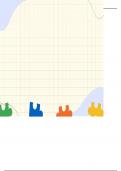Samenvatting
Summary All articles - Identity, Diversity and Inclusion
This is a summary of all articles from the course Identity, Diversity and Inclusion (2021). It mainly consist of quotes from the articles which highlights the most important things to know for the exam. I also added parts from the lecture at the end of an summary article so you can see where the fo...
[Meer zien]













